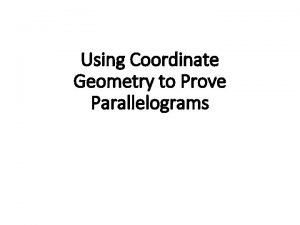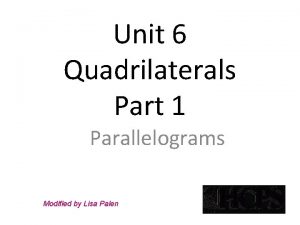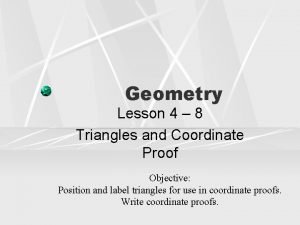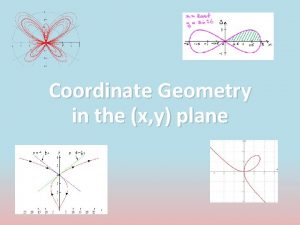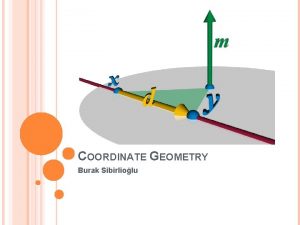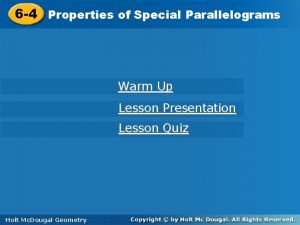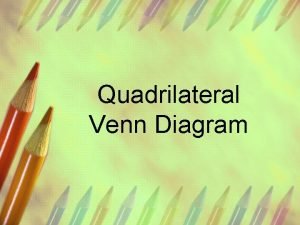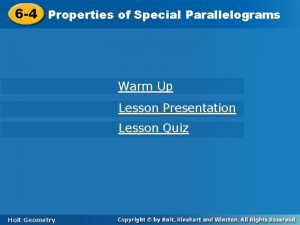Using Coordinate Geometry to Prove Parallelograms Using Coordinate











- Slides: 11

Using Coordinate Geometry to Prove Parallelograms

Using Coordinate Geometry to Prove Parallelograms • Definition of Parallelogram • Both Pairs of Opposite Sides Congruent • One Pair of Opposite Sides Both Parallel and Congruent • Diagonals Bisect Each Other

L 34 Opener QUAD JOHN J(-3, 1) O(3, 3) H(5, 7) N(-1, 5) a) Use the slope formula and calculate the slope of all four sides. b) Write down and fill in the blanks Segments with the same slopes are _____. Since opposite sides are _____ then QUAD JOHN is a _______ by the ________. c) Graph QUAD JOHN and check that it is a parallelogram.

Definition of a Parallelogram Use Coordinate Geometry to show that quadrilateral ABCD is a parallelogram given the vertices A(0, 0 ), B B(2, 6), C (5, 7) and D(3, 1). I need to show that both pairs of opposite sides are parallel by showing that their slopes are equal. A C D

Definition of a Parallelogram Use Coordinate Geometry to show that quadrilateral ABCD is a parallelogram given the vertices A(0, 0 ), B B(2, 6), C (5, 7) and D(3, 1). AB: m = 6 – 0 = 6 = 3 2– 0 2 AB ll CD CD: m = 1 – 7 = - 6 = 3 3– 5 -2 BC: m = 7 – 6 = 1 5– 2 3 AD: m = 1 – 0 = 1 3– 0 3 A C D ABCD is a Parallelogram by Definition BC ll AD

Both Pairs of Opposite Sides Congruent Use Coordinate Geometry to show that quadrilateral ABCD is a parallelogram given the vertices A(0, 0 ), B(2, 6), C (5, 7) and D(3, 1). C B I need to show that both pairs of opposite sides are congruent by using the distance formula to find their lengths. A D

Both Pairs of Opposite Sides Congruent A Use Coordinate Geometry to show that quadrilateral ABCD is a parallelogram given the vertices A(0, 0 ), B(2, 6), C (5, 7) and D(3, 1). AB = (2 – 0)2 + (6 – 0)2 CD = (3 – 5)2 + (1 – 7)2 = 4 + 36 = 40 AB CD BC = (5 – 2)2 + (7 – 6)2 = 9 + 1 = 10 C B D = 4 + 36 = 40 AD = (3 – 0)2 + (1 – 0)2 = 9 + 1 = 10 BC AD ABCD is a Parallelogram because both pair of opposite sides are congruent.

One Pair of Opposite Sides Both Parallel and Congruent Use Coordinate Geometry to show that quadrilateral ABCD is a parallelogram given the vertices A(0, 0 ), B(2, 6), C (5, 7) and D(3, 1). C B I need to show that one pair of opposite sides is both parallel and congruent. ll (slope) and (distance) A D

One Pair of Opposite Sides Both B Parallel and Congruent Use Coordinate Geometry to show that quadrilateral ABCD is a parallelogram given the vertices A(0, 0 ), B(2, 6), C (5, 7) and D(3, 1). BC: m = 7 – 6 = 1 5– 2 3 BC ll AD BC = (5 – 2)2 + (7 – 6)2 = 9 + 1 = 10 A C D AD: m = 1 – 0 = 1 3– 0 3 AD = (3 – 0)2 + (1 – 0)2 = 9 + 1 = 10 BC AD ABCD is a Parallelogram because one pair of opposite sides are parallel and congruent.

Diagonals Bisect Each Other Use Coordinate Geometry to show that quadrilateral ABCD is a parallelogram given the vertices A(0, 0 ), B(2, 6), C (5, 7) and D(3, 1). B I need to show that each diagonal shares the SAME midpoint. A C D

Diagonals Bisect Each Other C B Use Coordinate Geometry to show that quadrilateral ABCD is a parallelogram given the vertices A(0, 0 ), B(2, 6), C (5, 7) and D(3, 1). A The midpoint of AC is 0+5 , 0+7 2 2 5 , 7 2 2 The midpoint of BD is 2+3 , 6+1 2 2 5 , 7 2 2 ABCD is a Parallelogram because the diagonals share the same midpoint, thus bisecting each other. D
 How could you use coordinate geometry to prove that bc ad
How could you use coordinate geometry to prove that bc ad How to prove a parallelogram in coordinate geometry
How to prove a parallelogram in coordinate geometry Theorem of rectangle
Theorem of rectangle What proof uses figures on a coordinate plane to prove
What proof uses figures on a coordinate plane to prove The sine rule for a triangle states that
The sine rule for a triangle states that Lewis dot structure and molecular geometry
Lewis dot structure and molecular geometry 4 electron domains 2 lone pairs
4 electron domains 2 lone pairs Covalent bond order
Covalent bond order Coordinate geometry formula
Coordinate geometry formula Coordinate geometry gcse
Coordinate geometry gcse Coordinate geometry in the (x y) plane
Coordinate geometry in the (x y) plane Coordinate geometry practice questions
Coordinate geometry practice questions
